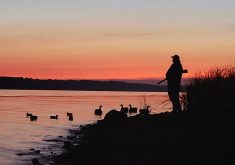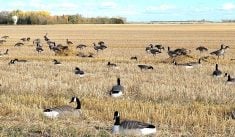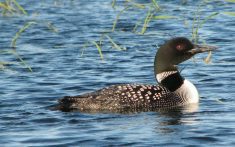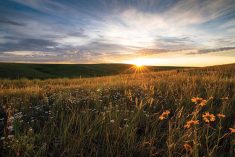There’s a timeless performance waiting for dance enthusiasts at this time of year.
The performers are as strikingly adorned as they would be in a major ballet company, if a bit more camera shy. The stage is the natural landscape of the Prairies, and the audience is anyone ambitious enough to get up at 3 a.m. for the show, not to mention forward thinking enough to set up a blind ahead of time.
Those dedicated few get to watch the grouse dance.
Read Also

Cooking cabbage deserves revival
Cabbage recipes don’t need to be boring. Rediscover the taste, diverse uses and local Prairie food traditions of this leafy green
Why it matters: While not as threatened as other Prairie bird species, habitat has tightened for the sharp-tailed grouse.
I spent many spring mornings hunkered at the edge of a sharp-tailed grouse dancing ground in my university days, and my favourite part was always that first arrival on the scene. The pre-dawn silence would suddenly be broken by a muffled rumble as a flock of males flew in from their overnight roosts.
The roar of beating wings overwhelmed the senses for a moment, before silence prevailed as the birds landed. After a pause to scan for danger, they would scurry into pre-arranged positions. The games would begin.
I will happily nominate the dance of the sharp-tailed grouse as one of the most remarkable natural sights that nature can offer in these parts.
Getting to know the grouse
I was handed a remarkable opportunity to work on a field study of the species for two seasons in my undergraduate days. Looking back, I see that the professor running the study showed faith that I didn’t deserve. I had lots of fishing, hunting and camping experience, but I was a city kid with no field work qualifications or rural living.
It was a far cry from the following weeks spent in a lonely hunter check station, where the last few farms gave way to a large and remote wildlife management area.
Word seeped into the community that the city kid was doing something with (to?) prairie chickens. Folks saw me as mostly harmless – probably a danger to myself more than anything – and started to ask polite questions about what I was doing.
That led to longer chats over coffee and cookies at kitchen tables and, in one case, an invitation to forage from an ample garden. I felt welcomed after folks started to drop by to visit, and I got a few invites to local social events. The unfailing courtesy and kindness of rural people came through once the ice had been broken.
I didn’t know it then, but it was a priceless, entry-level education into how conservation folks should live and work in farm country.
The leks
Everyone associates sharp-tailed grouse with grasslands. In fact, most people call them “prairie chickens,” though there is a distinct species with that name found in grasslands further south.
Sharp-tailed grouse inhabit open areas like grasslands, pastures and haylands, particularly where those areas also have patches of shrub land and woods.
Cattle pastures, with lots of native range, a few tame hay fields and a bit of cultivation, can be especially good habitat.

Sharp-tailed grouse are known as a lek species, which means that males congregate in one place (biologists call that site a lek) to defend territory and attract females. Because leks are usually found in open areas, one explanation for this behavior is that it’s a defence against predators looking for an easy meal – in this case, distracted, amorous males.
The behavior didn’t evolve only in sharp-tailed grouse. It’s found in many unrelated species, including other birds, mammals, fish and even insects. It happens, however, that North America’s roster of prairie grouse – sharp-tailed, prairie chicken and sage grouse – are all lek species.
In all my time spent watching grouse on leks (it probably adds up to around 250 hours) I watched aerial attacks by goshawks, owls and a harrier, and sneak attacks via foxes and coyotes, all of which went in favour of the grouse. Lots of eyes and a good vantage point seems to work.
A grouse lek, which often has a footprint about the size of a modest bungalow, may be used for decades. Leks will be abandoned if they become overgrown with dense vegetation or the birds disappear from the area.
Grassland pastures or haylands are most commonly used, but idle grasslands and cultivated fields may also host leks. It’s common lore that leks will be atop hills or ridges, but I have seen many on lower-lying land and, once or twice, watched birds dance in sodden hay meadows.
Regardless of location, the key is good visibility.
A lek can function with as few as four or five birds, but 10 to 25 is a more common number. At the top end, the largest I saw peaked at 45 birds. In good sharp-tailed grouse country, one good-sized lek per section is possible.
With all the displaying and squabbling going on in close quarters, it can look like pure mayhem. But there is an underlying structure and hierarchy governing the participants.
Success is all about location. Birds nearest to the lek’s centre have the smallest territories and the most challengers, but the reward is more mating opportunities. Males on the edges have more elbow room, but little chance of mating-game victories.
As with all dances, the males start with the basic position. The body is horizontal, but the tail feathers are held vertically and the wings are spread. They look a little like planes ready for takeoff.
The stance is complemented by large purple air sacs on the side of the neck and bright yellow combs above the eyes.
From this position, they gyrate around their territories with feet stamping so fast it almost becomes a blur. The birds also issue frantic clucks, yelps and coos into the morning chill.
It only takes one bird to start dancing before the lek goes from dead quiet to vigorous activity, as if a switch was turned on. After some frantic dancing and quarreling with neighbours, it goes back to silence and the birds engage in staring contests.
Watch two neighbours for a bit and you will soon see that they know the boundaries between their two territories, down to the last inch. Expect to see feints, bill-jabs and the odd full-on fight to defend the lines.
Lek use picks up in late March and peaks from late April to mid-May. That’s when females visit, and the intensity kicks up several notches. Females are easily spotted because they wander through the lek mostly unmolested. If a female likes what she sees, she settles on the ground, is quickly mounted by the nearest male and it’s all over in a few seconds.
The female will then make a nest and raise the young alone. If a nest is lost to predators or farm machinery, she may try again, which starts with another visit to the lek. This explains why males display well into June.
Observing the dance
Scratching a lek visit off your bucket list takes perseverance but, in addition to seeing the grouse’s remarkable displays first-hand, the quest also takes you to lovely places at the best time of day. You will likely see dozens of other bird species, not to mention foxes, coyotes and deer.
Start where you know there are decent numbers of birds. If you regularly encounter flocks of a dozen or more in certain spots, that’s a good place to start, as there may be a lek within a mile or so. If you don’t have a place to start, talk to grouse hunters and local bird enthusiasts.

When there is a sunny, calm morning in the forecast, rise early enough to reach your search area about 30 minutes before sunrise. Listen for sharp-tail grouse sounds. Their deep cooing and clucking can carry a long way on a windless morning.
If you see any birds flying, there is a good chance they’re headed to a lek, so note the direction. If you strike out at one spot after five minutes, move about a quarter of a mile down the road and do it again, keeping close to good sharp-tail habitat.
You’ll know you’re getting close if you hear the intermittent, low rumble of dancing birds. On a calm day, the sound of foot stomping can travel up to half a mile. If you hear clucking and chirping as well, and see birds scooting round on the ground, you’ve found the spot.
If you want an up-close encounter, visit the landowner to ask for permission. Chances are, they already know about the site.
For known lek locations, pop-up blinds normally used for hunting are fine and it’s best to set one up ahead of time. Put it about 20 metres from the lek edge on the eastern side to avoid looking into the sunrise. Pick a clear, calm day for your visit. If you scare the birds off with your arrival, they will likely sift back before long.
Joining the brigade
Compared to species that are more at risk, conservation biologists see sharp-tailed grouse as holding their own across a large range. The birds are still reasonably plentiful in good habitat areas and there are many opportunities for keeners to track down the prairie dancers.
That said, a bird that used to be widely distributed through farm country is now found in fewer places. As we lose mixed farms and lands dedicated to cattle production, we also see sharp-tailed grouse habitat ebbing away.
Manitoba’s Sharp-Tailed Grouse Monitoring Program encourages citizens to engage in a little biological data collection. Tim Poole, an endangered species biologist with Manitoba Natural Resources and Northern Development, co-ordinates about 25 volunteers across the province. Conducted from mid-April to mid-May, volunteers are asked to visit known leks and conduct a count close to sunrise.
When I asked Poole what drives his volunteers, he said the mix includes folks who hunt grouse, as well as keen naturalists. While they come to it from different experiences, they all wish to contribute to conservation while taking in the wonders of nature.
Poole has studied wildlife on two continents, but even with that breadth of experience, he sees the dance of the sharp-tailed grouse as something special.
“It’s a unique experience,” he said. “When it comes to bird displays, there is nothing that matches it in this area.”
He also it that the monitoring program connects people to grasslands, Manitoba’s most threatened ecosystem.
Dancing ground displays aside, it’s easy to see why everyone likes sharp-tailed grouse. Rural folks appreciate that the birds don’t leave just because it gets cold. As we face the adversity of what sometimes seems like endless, harsh winter days, seeing the birds toughing it out on a hay bale or treetop can bring a smile to anyone’s face.
















